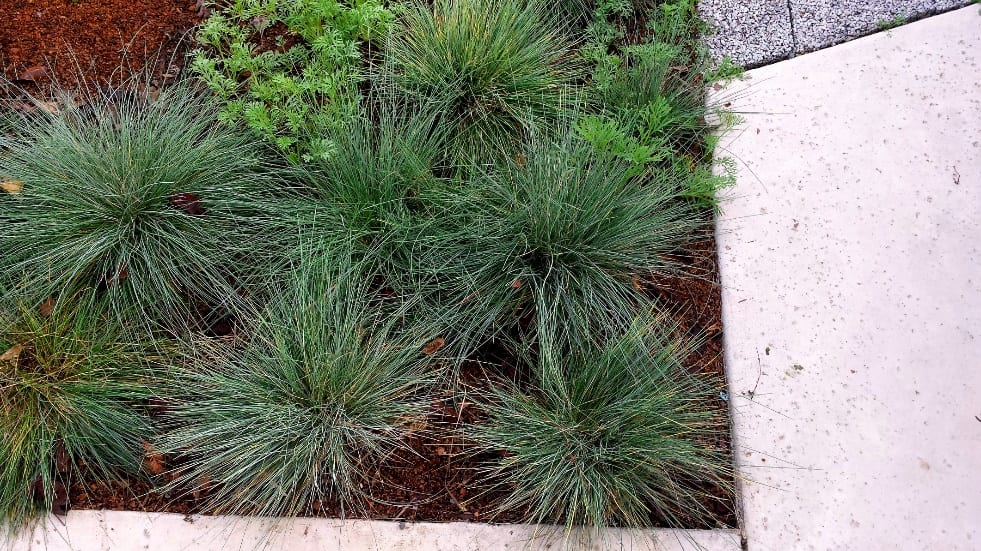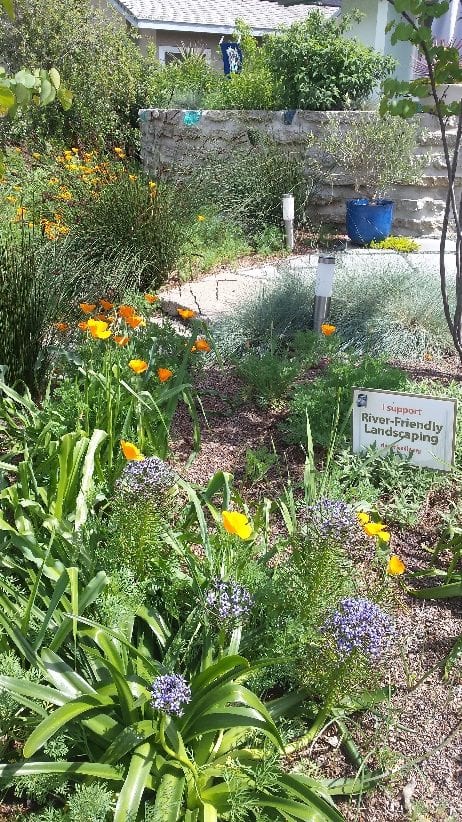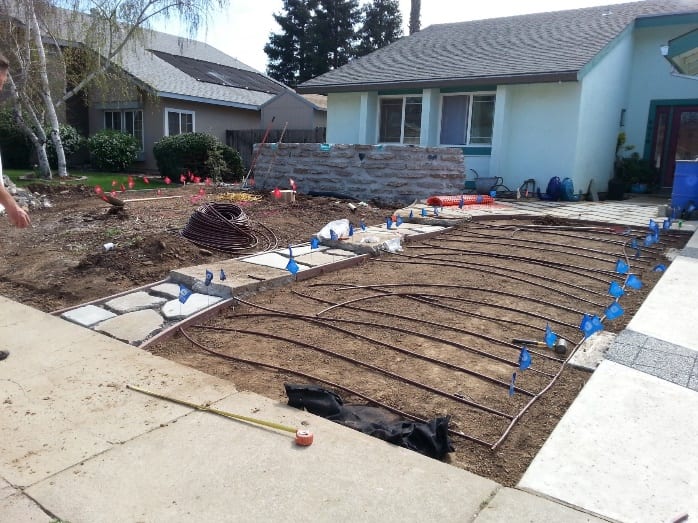by Soleil Tranquilli
After years of not quite getting around to designing my own landscape, I finally took the first steps toward a complete renovation in 2009. Eight years later, the renovated yard demonstrates our priorities: water conservation, use of predominantly native plants, reuse of materials, and support of wildlife, especially of pollinators. My home in Elk Grove, CA now showcases principles of ecological design serving as a demonstration garden. We have been featured twice on the sustainable landscape tour “Gardens Gone Native” tour, in the Northern Sacramento Valley of California, as well as my own local sustainable garden tour, Elk Grove Greener Gardens.
Laying the Groundwork
I began the project with sheet mulching in the spring of 2009. The mulch stayed in place for seven years, until the renovation began winter/spring 2015.

Before the renovation, the gardens were overrun with California poppies and Bermuda grass, and water ran from the roof and driveway during storms.

All that long term mulching created a very deep sponge-like soil filled with worms, even though we do have heavy clay to work with.

Recycled concrete (aka Urbanite) from the old driveway was saved for use in pathways, wall, and steps.

A new micro-patio behind a seat wall planter allows us to view wildlife visiting the raised plantings all year round.

Recycled windshield glass, also called Kryptonite, is incorporated into the wall and other areas for a sparkle of color.
Planting
Our planting theme was sages and other pollinator favorites, keeping to a low and cool palette. We used swaths of plants as much for visual impact as for pollinator delight. By paying attention to the structural details of the garden, we added color and textural interest that will hold the eye even when the garden is more spare in winter.
Special site considerations included a very persistent Bermuda lawn, heavy clay soils, feral cats, and a mostly shady northern exposure which receives extreme exposure from late afternoon western sun.

A suburban wind tunnel from east to west is managed with close plantings at edges of sidewalk to crowd out weed seed migrations, taller shrubs near the house and patio break wind flows.

Small trees and larger shrubs create multiple perches and cover for smaller birds, great for observing from the office windows.
Adding Lighting
An important aspect of the renovated garden is lighting. Although we are still awaiting professional low voltage landscape lighting, we know this will be the icing on the cake. In the meantime, we are field testing low cost solar options as found at Costco and other local sources. While costs are low, we also have found the look, product quality, and length of effect suffer greatly.
We upgraded the outdoor light fixtures on the house with a lower profile modern design to accent our new landscape. The professional grade lighting is Dark Sky friendly, see darksky.org. Scientific evidence suggests that artificial light at night has negative and deadly effects on many creatures including amphibians, birds, mammals, insects, and plants that we want to invite into our landscape.
River Friendly Landscaping
My landscape design highlights our water management system that slows the water flowing from roofline to gutter. This landscape is located within the Laguna Creek Watershed; stormwater flows into Elk Grove Creek. Rainfall is checked and reabsorbed into the soil via several strategies: bioswales, rain garden, rain barrels, rain chain. In fact, this garden shows no runoff onto the sidewalk until storm events reach about 3″ of rainfall in 24 hours.

The rain garden is hard at work during a storm. The clay soil allows no runoff, even with storm events of 3” rainfall.
A bonus tour of the back side yard reveals a Laundry to Landscape greywater system that we use to grow fruit trees and other moderate water use edibles, as installed by GrowWater.org. Shallow pits deposit water between edible plantings.
Water-wise Hydrozoning
All front yard plants are Water Use for Classification of Landscape Species (WUCOLS) indicating they are low and very low water use, with the exception of plants in pots, rain garden, and side yard edibles.
Professionally designed, installed, tweaked, and maintained by California EcoLandscapers, our garden is dedicated to gardening matriarchs Betty, Willa, Clara, and Martha.
Many thanks to all our collaborators and accomplices.
Resources
Landscape Design: Soleil Tranquilli, Tranquill Gardens 916-685-8010
Landscape Contractor: Eric Zemlicka, Zscapes
Electrician: Terry Steele, Steele Electric
Water Catchment, L2L & Greywater Installation: Chris & Rodger of GrowWater.org
Rain Gutters: TopRank HVAC
General Contractor: Ed Dyer
Stone and Kryptonite: MidValleyRock
Walnut Shell Mulch: RoundTree
Mulch: Nicolai Laquaglia ASustainableGarden.com
Permeable pavers: Xeripave
Exterior light fixtures: Lofting Lighting
Netafim: Ewing Irrigation
Irrigation Controller: On Point Water Sage
Garden Art: The Shaman’s Garden
Nursery & Materials
Green Acres
Morningsun Herb Farm
Devil Mountain Nursery
Matsuda’s
Digging Dog Nursery
CalFlora Nursery
LasPilitas
Four Winds Nursery
Cornflower Farms
About the Author
Soleil Tranquilli holds AA degrees in Horticulture and advanced certification with The California School of Garden Design. Locally she is an EcoLandscaper and a Qualified Water Efficient Landscaper. Soleil’s landscapes strive to unify home and garden while honoring the environment and natural resources. She is deeply committed to water efficient landscapes (WEL) and delighted to create human and wildlife habitat with California native plants. Inviting folks back into the garden is her passion. Visit her at http://www.tranquillgardens.com.
***
Each author appearing herein retains original copyright. Right to reproduce or disseminate all material herein, including to Columbia University Library’s CAUSEWAY Project, is otherwise reserved by ELA. Please contact ELA for permission to reprint.
Mention of products is not intended to constitute endorsement. Opinions expressed in this newsletter article do not necessarily represent those of ELA’s directors, staff, or members.















